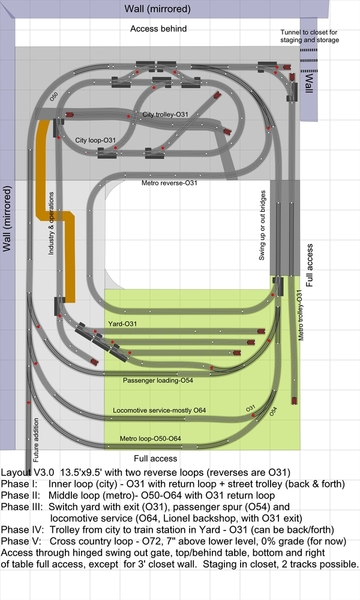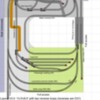I'm working on a new 10'x14' layout and I'm new to the hobby... but I have a layout designed and could really use some insight into where to isolate rails for conventional control first and then DCS and/or Legacy later. I have two running loops, a couple of trolleys for back and forth and a yard, which the train can also pass through (not a dead end) back out onto the main outer line. The inner city loop is relatively small O31 for lower speeds and yard access. The outer loop main line is O64 on average (one spot is O50). I have a couple of passing sidings on the outer loop, 5 dead-end sidings, a couple of reverse loop areas and a few areas for expansion. A picture is shown below and attached.
My question is where to isolate the center rail for all sidings and transitions between loops. I understand that to run conventional and DCS, separately or at the same time, that I'll need to have several power supplies and some DPDT switches but don't feel confident that I selected the right locations to insulate the center rail. I'm assuming at either end of a passing siding, at the entrance of any single-ended siding that may hold/store engines and other areas that clearly delineate operating blocks/loops.
In the figure isolated center rails are denoted with a red dot. If anyone can critique this I'd be really grateful and it will let me move forward more quickly. I'm kind of married to the layout since I already have good ideas where structures and other scenery will go and I don't want to alter that too much. I chose not keep to the "keep it simple stupid" (KISS) mantra and would like to have lots of opportunities. Oh, and on top of this layout is an elevated O72 totally isolated loop for running my bigger trains.
Thanks in advance for any help you can offer.
Kirk R.







